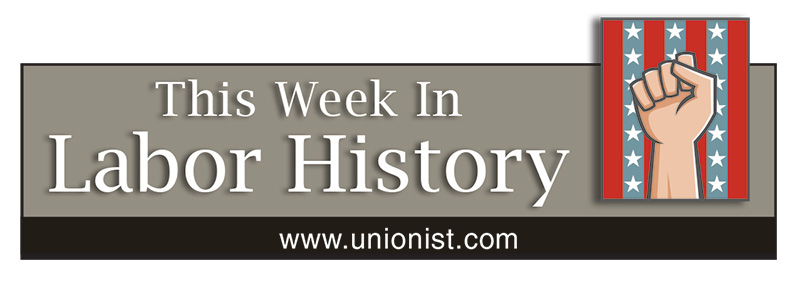
JUNE 13
1884 – Congress creates a Bureau of Labor under the Interior Department. It later became independent as a Department of Labor without executive status in the Department of Commerce and Labor. In 1913 it became the Department of Labor we know today.
JUNE 14
1872 – Unions are legalized in Canada.
1951 – The first commercial computer, UNIVAC I, is installed at the U.S. Census Bureau.
JUNE 15
1908 – The Metal Trades Department of what is now the AFL-CIO is founded.
1947 – The Congress of Industrial Organizations expels the Fur and Leather Workers union and the American Communications Association for what it describes as communist activities.
1990 – Battle of Century City, as police in Los Angeles attack some 500 janitors and their supporters during a peaceful Service Employees International Union demonstration against cleaning contractor ISS. The event generates public outrage that resulted in recognition of the workers’ union and spurred creation of an annual June 15 Justice for Janitors Day.
JUNE 16
1918 – Railroad union leader and socialist Eugene V. Debs speaks in Canton, Ohio, on the relationship between capitalism and war. Ten days later he is arrested under the Espionage Act and is eventually sentenced to 10 years in jail.
1933 – The National Industrial Recovery Act becomes law but is later declared unconstitutional. It establishes the right to unionize, set maximum hours and minimum wages for every major industry, abolishes sweatshops and child labor. The Wagner Act, in effect today, was approved two years later to legalize unionization.
JUNE 17
1864 – Twenty-one young women and girls making cartridges for the Union Army at the Washington, D.C. arsenal during the Civil War are killed in an accidental explosion. Most of the victims were Irish immigrants. A monument was later erected in the Congressional Cemetery, where 17 of the workers were buried.
1873 – Susan B. Anthony goes on trial in Canandaigua, N.Y., for casting her ballot in a federal election the previous November in violation of existing statutes barring women from the vote.
1903 – Mary Harris “Mother Jones” leads a rally in Philadelphia to focus public attention on children mutilated in the state’s textile mills. Three weeks later, the 73-year-old leads a march to New York City to plead with President Theodore Roosevelt to help improve conditions for the children.
1936 – Twelve trade unionists meet in Pittsburgh to launch a drive to organize all steelworkers. It was the birth of the United Steelworkers of America (then called the Steel Workers Organizing Committee). By the end of the year, 125,000 workers join the union in support of its $5-a-day wage demand.
JUNE 18
1941 – Union and civil rights leader A. Philip Randolph and others meet with President Roosevelt about a proposed July 1 March on Washington to protest discrimination in war industries. A week later, Roosevelt orders that the industries desegregate.
JUNE 19
1912 – Eight-hour work day adopted for federal employees.
1917 – AFL President Sam Gompers and Secretary of War Newton Baker sign an agreement establishing a three-member board of adjustment to control wages, hours and working conditions for construction workers employed on government projects. The agreement protects union wage and hour standards for the duration of World War I.
1937 – The Women’s Day Massacre occurs in Youngstown, Ohio when police use tear gas on women and children, including at least one infant in his mother’s arms, during a strike at Republic Steel.
1953 – ILWU begins a four-day general strike in sugar, pineapple and longshore to protest convictions under the anti-communist Smith Act of seven activists, “the Hawaii Seven.” The convictions were later overturned by a federal appeals court.
(Compiled by David Prosten, founder of Union Communication Services)

